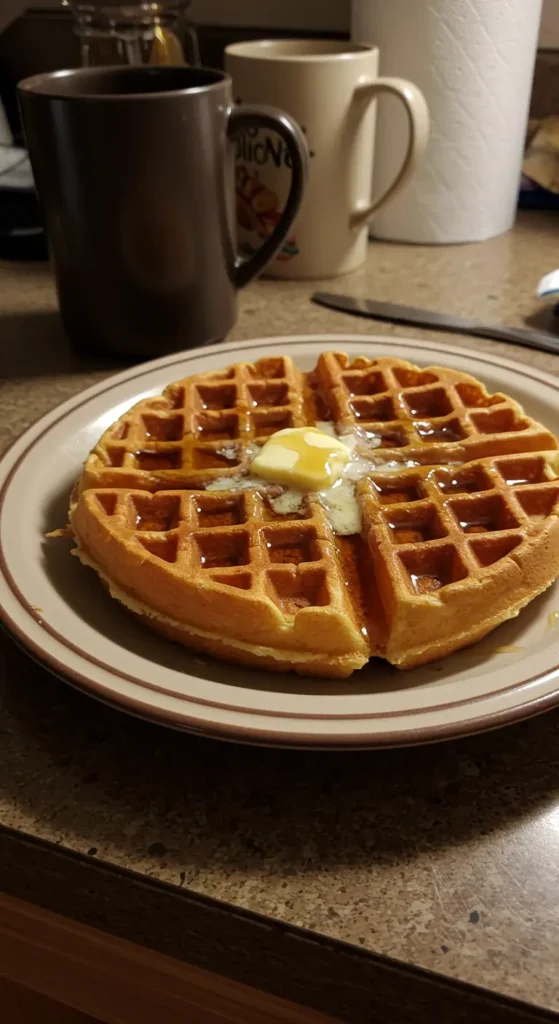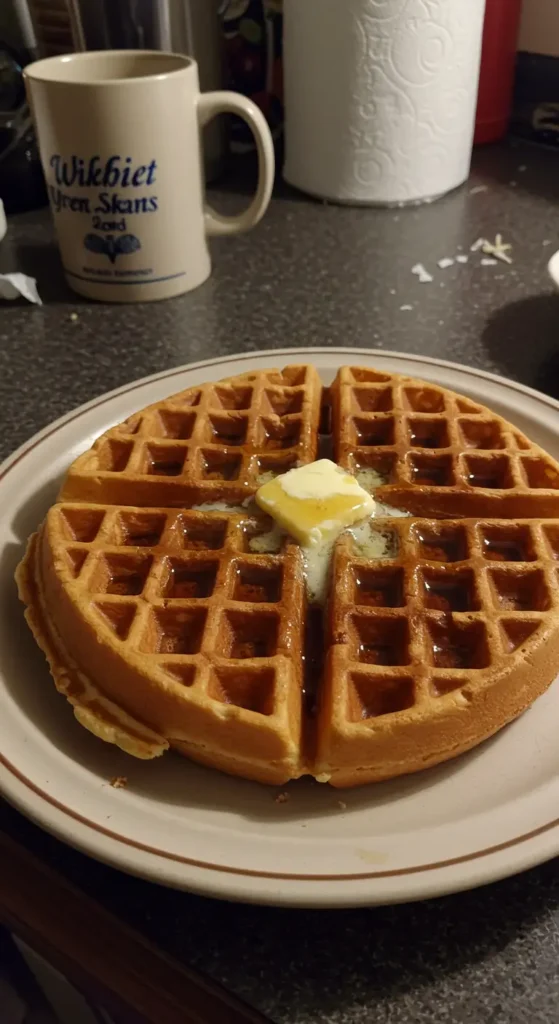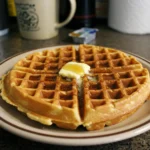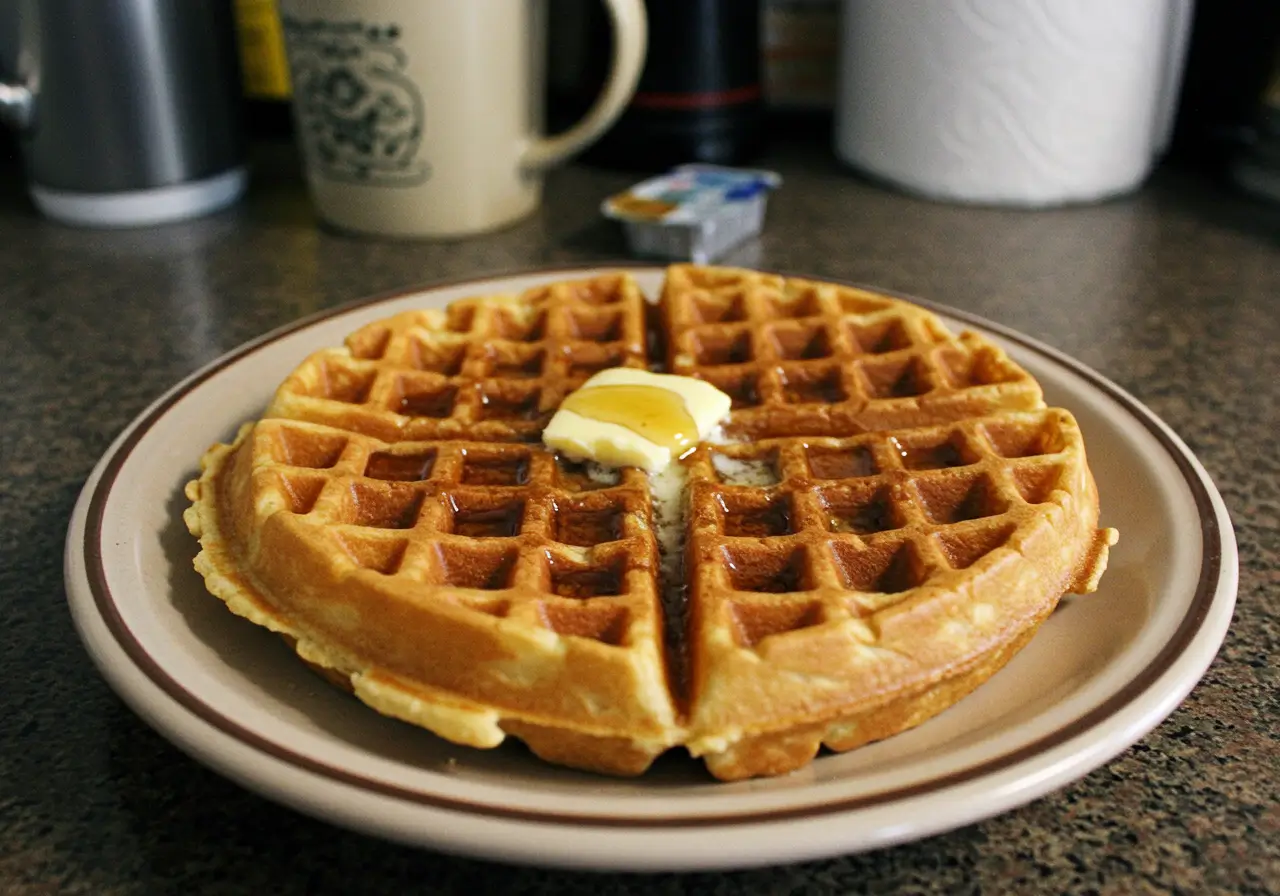Waffle Recipe
Table of Contents
Waffles aren’t just for weekend brunch anymore—they’re a warm, crispy, melt-in-your-mouth breakfast classic that everyone craves. Whether you’re flipping them on a lazy Sunday or serving them up for a weekday breakfast, getting your waffle recipe just right makes all the difference.
In this guide, we’ll break down everything you need to know—from the different types of waffles to expert tips, common mistakes, and step-by-step instructions. You’ll also find inspiration from top food blogs and answers to the internet’s most burning waffle questions. So, grab your whisk, fire up that waffle iron, and let’s dive in!
Understanding Waffle Types
Classic American vs. Belgian Waffles
When it comes to waffles, not all are created equal. The two most well-known types are American waffles and Belgian waffles, and each has its charm. American-style waffles are thinner, crispier, and usually made with a basic waffle recipe. They’re perfect for stacking and soaking in syrup, butter, or even fried chicken.
On the flip side, Belgian waffles are thicker, lighter, and come with deeper pockets. Thanks to yeast or whipped egg whites, they puff up beautifully. If you’re after a waffle that looks as good as it tastes, the Belgian version might just be your golden ticket.
Although both types start from a similar batter, the texture and final bite can vary wildly. That’s why knowing your waffle style matters before you reach for that iron.
Savory vs. Sweet Waffles
Waffles don’t always have to be sweet. Nope, not at all! Savory waffles are having their moment, made with add-ins like cheese, herbs, or even bacon (without pork, of course!). These are great for brunch or dinner, especially when topped with a runny egg or creamy sauce.
Still, for many of us, nothing beats a sweet waffle recipe topped with berries, maple syrup, or whipped cream. Whether you’re team sweet or savory, there’s a waffle out there for you.
Must-Have Ingredients for the Best Waffle Recipe

Flour, Eggs, and Milk: The Base Trio
Every unforgettable waffle recipe starts with a solid base—flour, eggs, and milk. These three are the backbone of most waffle batters. All-purpose flour keeps things simple and familiar, but if you’re experimenting, try whole wheat or oat flour for a slightly nutty taste and added texture.
Eggs are essential—they give waffles structure and richness. Want your waffles extra fluffy? Beat the egg whites separately and fold them in gently. It’s a little trick that goes a long way.
As for milk, most recipes call for regular dairy milk, but plant-based options like almond or oat milk work well too. Just make sure it’s unsweetened to keep things balanced.
Secret Additions: Vanilla, Buttermilk, or Yogurt?
Want to make your waffle recipe unforgettable? Add a splash of vanilla extract. It’s a simple flavor booster that takes things up a notch.
Buttermilk is another hero ingredient. It adds a tangy flavor and reacts with baking soda to create a super light, fluffy interior. Don’t have buttermilk? No worries. Mix milk with a dash of lemon juice and let it sit for a few minutes—voilà!
Some recipes even swap in Greek yogurt for added protein and creaminess. It thickens the batter and gives your waffles a heartier bite.
Toppings That Elevate Your Waffle Game
Here’s where it gets fun. Think beyond syrup. Fresh fruit, chocolate chips, crushed nuts, or a dollop of whipped cream can turn a good waffle into a great one. With the right toppings, even a simple waffle recipe can feel like a gourmet treat.
How to Make Waffles Step-by-Step

Prepping the Batter the Right Way
Before anything else, gather your ingredients. Trust me, nothing slows down the morning like hunting for vanilla while the waffle iron’s smoking! To start your waffle recipe off strong, sift your dry ingredients—flour, baking powder, a pinch of salt, and sugar—into a large mixing bowl. Sifting helps with airiness and prevents lumps.
Next, whisk your wet ingredients—eggs, milk (or buttermilk), melted butter, and a dash of vanilla extract. Combine the two mixtures gradually. Stir gently—don’t overmix! Overworking the batter can make waffles tough instead of fluffy.
If you’ve got time, let the batter rest for 5 to 10 minutes. This helps the flour hydrate and gives your waffles a softer texture. Little steps like this? They make a huge difference.
Tips for Using Your Waffle Iron Correctly
Ah, the waffle iron—your batter’s best friend. First off, make sure it’s fully preheated. Some irons have an indicator light, but you can also drop a bit of water on the surface; if it sizzles, you’re golden.
Lightly grease the plates, even if it’s nonstick. This prevents sticking and gives your waffle those irresistible crispy edges. Pour just enough batter to cover the grates—don’t overfill. Overflowing batter is a mess no one wants to clean up.
Close the lid gently and resist the urge to peek. Let the waffle cook for the full cycle. When the steam slows down, your waffle is probably ready. Crisp, golden, and just begging for toppings!
For more delicious recipes, check out this apple pie recipe on our site—it’s a perfect pairing for a cozy brunch.
Expert Waffle Recipes From Top Food Bloggers
The Kitchn’s No-Buttermilk Waffle Hack
Not everyone keeps buttermilk in the fridge—and that’s okay. The Kitchn’s clever waffle recipe uses regular milk, relying on whipped egg whites to deliver that light, airy bite. Their version skips the tang but brings serious fluff.
Their key trick? Separating the egg yolks and whites. The yolks get mixed into the batter first, while the whites are whipped to stiff peaks and folded in at the end. That’s the secret to waffles that are cloud-soft yet still crispy on the outside.
King Arthur’s Buttermilk Waffles Review
King Arthur Baking goes classic with a richer, more traditional take on the waffle recipe. Their batter includes buttermilk, eggs, and a touch of cornstarch—which helps with crispness.
These waffles are thick and tender, making them ideal for holding heavy toppings like fresh fruit, whipped cream, or even fried chicken. The recipe also scales well, so it’s a top pick for families or brunch gatherings.
Spatula In My Pocket’s Classic Recipe
If you want a no-fuss, foolproof waffle recipe, this one’s a gem. Spatula In My Pocket keeps it simple with pantry staples and quick steps. The batter comes together in minutes and cooks evenly, delivering reliable results every time.
Whether you’re new to waffle-making or looking for a go-to favorite, this recipe strikes a balance between ease and deliciousness.
Tools You Need to Make the Perfect Waffle
Waffle Irons: Belgian vs. Classic Models
If you’re serious about getting the best out of your waffle recipe, then the right waffle iron makes all the difference. Belgian waffle makers have deeper grids, giving you that thick, fluffy center with large pockets—ideal for catching syrup and fruit. Classic waffle irons, however, create thinner, crispier waffles that are just as satisfying, especially if you like a bit more crunch.
Choose based on what texture you love most. Still undecided? Look for a dual-purpose iron that can switch between styles. Handy, right?
Mixing & Measuring Tools That Help
Don’t overlook the small stuff! A reliable whisk, large mixing bowl, and accurate measuring cups ensure your waffle recipe turns out consistent every time. Using a ladle or measuring cup to pour the batter helps keep things clean—and prevents overflow.
And hey, if you’re into batch cooking, a cooling rack and airtight container will keep those golden beauties fresh longer. Little tools, big impact.
Common Mistakes to Avoid in Any Waffle Recipe
Overmixing the Batter
It might seem like a good idea to stir until perfectly smooth, but that’s a rookie mistake! Overmixing develops gluten, which can make waffles tough and chewy. For the best waffle recipe results, stop mixing once the wet and dry ingredients are just combined—even if it looks a bit lumpy. It’ll all come together on the iron.
Wrong Temperature Settings
Another biggie? Not heating your waffle iron enough. If the iron’s too cold, your waffles will end up pale and limp. Too hot, and they’ll burn on the outside while staying raw inside. So, always preheat your waffle maker thoroughly and test the first waffle before going full batch.
Skipping Rest Time Before Cooking
Yes, it’s tempting to dive right in—but giving your batter a few minutes to rest helps improve texture. Resting lets the flour hydrate and the bubbles settle, resulting in waffles that are lighter and more uniform.
Print
Waffle Recipe
- Total Time: PT25M
- Yield: Serves 4
- Diet: Vegetarian
Description
This waffle recipe creates golden, crispy-on-the-outside, fluffy-on-the-inside waffles that are perfect for any breakfast or brunch. Made with simple pantry ingredients like flour, eggs, milk, and butter, this recipe is beginner-friendly and easy to customize with toppings like fruit, whipped cream, or syrup. Whether you prefer Belgian or classic American-style waffles, this recipe delivers delicious results every time.
Ingredients
- 2 cups all-purpose flour
- 1 tsp salt
- 4 tsp baking powder
- 2 tbsp white sugar
- 2 large eggs
- 1½ cups warm milk (or buttermilk)
- ⅓ cup melted butter
- 1 tsp vanilla extract
- Optional: whipped cream, fresh berries, maple syrup
Instructions
- Preheat your waffle iron according to manufacturer’s directions.
- In a large bowl, whisk together the flour, salt, baking powder, and sugar.
- In a separate bowl, beat the eggs. Then stir in the milk, melted butter, and vanilla extract.
- Pour the wet ingredients into the dry and mix until just combined. Do not overmix.
- Let the batter rest for 5–10 minutes.
- Lightly grease the waffle iron with butter or spray.
- Pour batter into the waffle iron and cook until golden and crisp.
- Serve warm with your choice of toppings.
Notes
- Use buttermilk for a tangier flavor and fluffier texture.
- If you don’t have buttermilk, add 1 tbsp lemon juice to regular milk and let it sit for 5 minutes.
- Resting the batter helps improve waffle texture.
- For crispier waffles, cook slightly longer or add more butter to the batter.
- Prep Time: PT10M
- Cook Time: PT15M
- Category: Breakfast
- Method: Waffle Iron
- Cuisine: American
Nutrition
- Serving Size: 1 serving
- Calories: 379
- Sugar: 9g
- Sodium: 899mg
- Fat: 16g
- Saturated Fat: 9g
- Unsaturated Fat: 6g
- Trans Fat: 0g
- Carbohydrates: 48g
- Fiber: 1g
- Protein: 10g
- Cholesterol: 113mg
Keywords: waffle recipe, homemade waffles, fluffy waffles, Belgian waffles, crispy waffles, breakfast waffles, easy waffle mix
Frequently Asked Questions – FAQs
Can I freeze waffle batter or cooked waffles?
Yes, absolutely! If you’ve made a big batch or just want to save time, both the waffle recipe batter and the cooked waffles freeze well. For batter, store it in an airtight container and freeze for up to one month. Just give it a good stir once thawed. Cooked waffles can be frozen too—lay them flat on a baking sheet to freeze individually, then transfer to a freezer bag. Reheat in a toaster or oven, and they’ll taste just like fresh!
How do I prevent my waffles from sticking?
This one trips up even seasoned home cooks. Always preheat your waffle iron thoroughly and lightly grease it before each use—even if it’s non-stick. Also, avoid batters with too little fat, as that’s often the culprit. A good waffle recipe balances moisture and oil to prevent sticking and give you that perfect golden crust.
What’s the difference between pancake and waffle batter?
Great question! While they share similar ingredients, waffle batter usually has more fat and sugar. That’s why waffles come out crispier and richer, while pancakes are softer and fluffier. So, don’t swap one for the other—they’re built differently.
Is baking soda or baking powder better?
Both are leavening agents, but they behave differently. Most waffle recipes rely on baking powder for consistent rise. Baking soda needs an acid (like buttermilk) to work properly. So choose based on your ingredients—and sometimes, both are used for extra lift!

